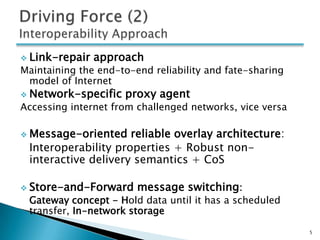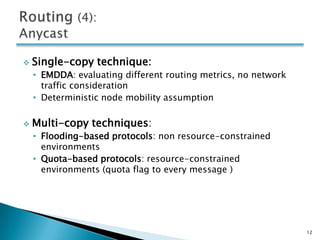Delay Tolerant Network - Presentation
- 2. Many evolving wireless networks have characteristics different from the Internet. • The instability of the link • Long propagation and queuing delays • Extremely asymmetric data rate • High link error rates Delay Tolerant networks are designed to provide • reliable transmission • Interoperable communications between wide range of networks 2
- 3. The Interplanetary Internet initiative: find a solution & suggestion network architecture, support reliable transmission between a station on the Earth and satellites, with an overlay network concept IRTF DTN Research Group: Interplanetary Internet under challenged networks DARPA Disruption Tolerant Networking program: Protocols for transmitting bundles to DTN nodes 3
- 4. Path and Link • High Error and Asymmetric Rate • Disconnection • Long and Variable Delay Network • Intermittent Connectivity • Security End System • Limited Longevity • Low Duty Cycle Operation • Limited Resources 4
- 5. Link-repair approach Maintaining the end-to-end reliability and fate-sharing model of Internet Network-specific proxy agent Accessing internet from challenged networks, vice versa Message-oriented reliable overlay architecture: Interoperability properties + Robust non- interactive delivery semantics + CoS Store-and-Forward message switching: Gateway concept - Hold data until it has a scheduled transfer, In-network storage 5
- 6. Region • Regional network concept • Interconnect different networks • Own communication protocol • Unique ID Node • Host: Sends or receives bundles and requires storage for queuing bundles. • Router: Forwards each bundles in the same DTN region, requires storage to store incoming packets • Gateway - support interoperability: interconnection point, forwards bundles to other DTN regions with different protocol stacks. 6
- 7. Bundle: message • Bundle header: Fragmentation • Control information: handling, storing, disposing • Source-application’s user data Fragmentation • To increase the possibility of delivery & increase performance • Proactive fragmentation • Predicted Contact volume + Optimize its usage • Reactive fragmentation • disconnection while transmitting fragmented bundles + Send smaller fragments 7
- 8. Bundle Layer (2) 8
- 9. Class of Service (2) 9
- 10. Name Tuple : • Region: Globally unique, reduce forwarding tables size • Entity Name: Identifier in specified region, not globally unique Contact Knowledge Oracle:encapsulate particular knowledge of network (Null, Contact Summary, Complete Contact, Queuing, Traffic On Demand) Group Membership Oracle:encapsulate particular knowledge of group dynamic (Local, Delay, Complete) 10
- 11. Objective: Maximize the probability of message delivery • time-varying multi-graph: no guarantee of the availability of the next hops link • Asymmetric data rate sender vs. receiver • high error rate link: retransmission • Contact intervals and volumes: unknown precisely ahead of time Routing Algorithm Class • Zero Knowledge: Poor performance • Complete Knowledge: Complete knowledge • Partial Knowledge: Route message independently based on the future traffic demand. 11
- 12. Single-copy technique: • EMDDA: evaluating different routing metrics, no network traffic consideration • Deterministic node mobility assumption Multi-copy techniques: • Flooding-based protocols: non resource-constrained environments • Quota-based protocols: resource-constrained environments (quota flag to every message ) 12
- 13. Unicast-based routing (UBR) Broadcast-Based Routing (BBR) Tree-Based Routing (TBR) Group-Based Routing (GBR) Context Aware Multicast Routing Static tree-based routing (STBR) Dynamic Tree-Based Multicasting Algorithm (DTBR) Context Aware Multicast Routing (CAMR) 13
- 14. Issues in bundle layer • Vulnerable to attack because it is an overlay network • Bundles can be modified • Unauthorized insertion of bundles. • Accept only authenticated messages Bundle Security • Authentication is carried out in routers and gateways • Public-key cryptography • both users and forwarders have their own key-pairs and certificates • A sender uses its private key to sign bundles and create bundle-specific signature. • A forwarding node replaces the sender’s signature with its own. 14
- 15. Open Issues in Bundle Security • The level of flexibility The bundle security protocol prevents insecure combination of application such as including plain-text signatures. Can support VPN but the complexity can cause high cost • Key Management No key management schemes exist in DTN deployments Existing schemes need hard coding. • Canonicalization of bundles Requires the same bytes of bundle of signature for integrity Bundles may be changed during traversal between nodes 15
- 16. Analyticalresearch, Mobility model Free-space Optical Communications: smart mobile phone-based mobile ad-hoc networks (MANETs) Radio Frequency (RF) Ultra-Wide Band (UWB) Acoustic (Sonar, Ultrasonic) 16
- 17. Outer Space / Deep-Space Networks Inter Planetary Networks: communication network robustness, timeliness data return Terrestrial Civilian Network Mule Networks (ZebraNet), Challenge Links (SenDT) Acoustic underwater networks Battlefield networks 17
- 18. Overview • Developed by the University of Waterloo • Providing low cost Internet services to the poorest villages • Vehicles are used to deliver data • Services: birth, marriage, and death certificates Medical consultation and agricultural problems • Key concepts for a robust system Low-cost(70$/kiosk/month) low-power kiosk controller (6~8W) Using refurbished PCs without hard disks Free software Figure 11. KioskNet overview S.Guo, M.H. Falaki, U.Ismail, E.A. Oliver, S.UrRahman, A. Seth, M.A. Zaharia, and S.Keshav. “Design and Implementation of the KioskNet System (Extended Version)”. [Online]. 18
- 19. Components • Kiosk Kiosk controller provide a network boot function, a network file system, user management, and network connectivity • Ferries a car, buses, motorcycles or trains contact with kiosk controllers and gateways using opportunistic ways • Gateway connected to the Internet through DSL or broadband receives data from a ferry and uploads the data to the proxy • Proxy Support communication between kiosk users and a legacy server • Legacy Server Typical servers supporting applications such as IMAP, SMTP and HTTP 19
- 20. Security Architecture • Entities KioskNet Franchisers, Franchisees, Users, Application Service providers • Certificate All entities have a 2048-bit RSA key and a public key Proxy broadcasts a public key for users, franchisees and ASPs • Infrastructure Integrity Digital signatures are used on all remote commands and software updates from franchiser • User data protection This system offers encrypted virtual space for each user’s home directory 20
- 21. The main goal of a DTN • Interoperability between different kinds of networks in wide-ranging regions even though many limitations • Reliable transmission based on overlay network The implementation of DTNs will be a good solution for challenged networks • For example: KioskNet 21
- 22. Questions? 22
Editor's Notes
- #15: Unauthorized insertion of bundles- Can cause serious threats because of the node’s limited resources.- Can be exploited by increasing resource consumption (i.e. DoS attack)
- #16: The level of flexibility The bundle security protocol prevents insecure combination of application such as including plain-text signatures.May support a VPN but the complexity can cause high cost for implementationKey ManagementNo key management schemes exist in DTN deploymentsExisting schemes need hard coding. Accordingly, replacement of trusted keys in all nodes makes it difficult to adopt this scheme. Canonicalization of bundlesThe definition of a canonical bundle form is an open issue for data integrityRequires the same bytes of bundle of signature for integrity


















![ Overview
• Developed by the University of Waterloo
• Providing low cost Internet services to the poorest villages
• Vehicles are used to deliver data
• Services:
birth, marriage, and death certificates
Medical consultation and agricultural problems
• Key concepts for a robust system
Low-cost(70$/kiosk/month)
low-power kiosk controller (6~8W)
Using refurbished PCs without hard disks
Free software
Figure 11. KioskNet overview
S.Guo, M.H. Falaki, U.Ismail, E.A. Oliver, S.UrRahman, A. Seth, M.A. Zaharia, and S.Keshav.
“Design and Implementation of the KioskNet System (Extended Version)”. [Online].
18](https://image.slidesharecdn.com/delaytolerantnetworkdraft3-120208115013-phpapp01/85/Delay-Tolerant-Network-Presentation-18-320.jpg)



